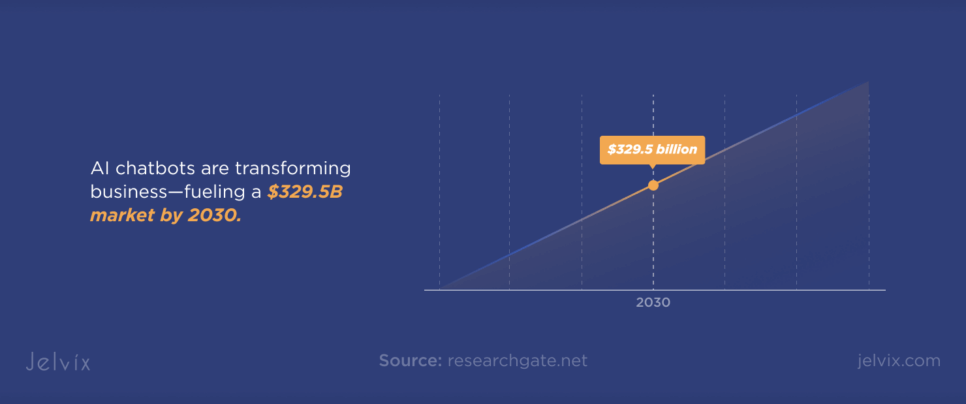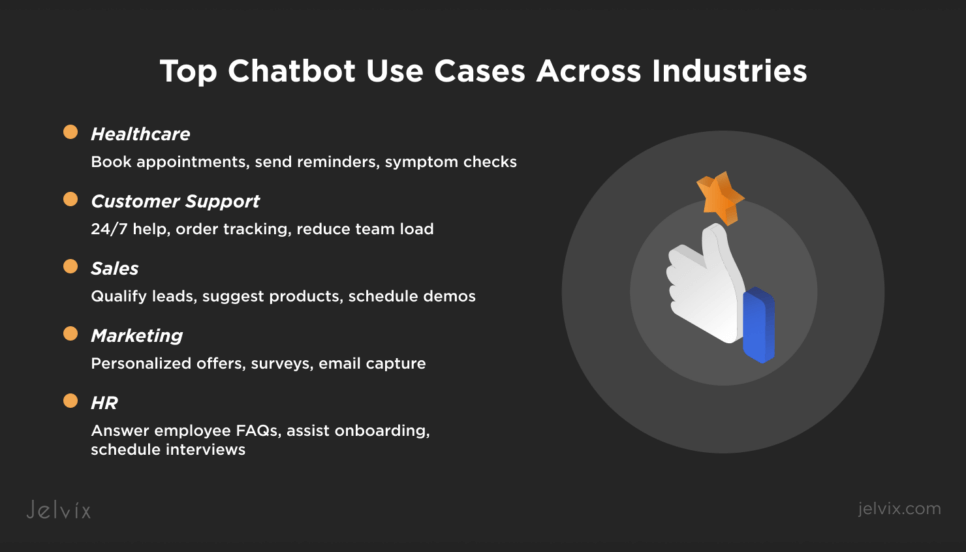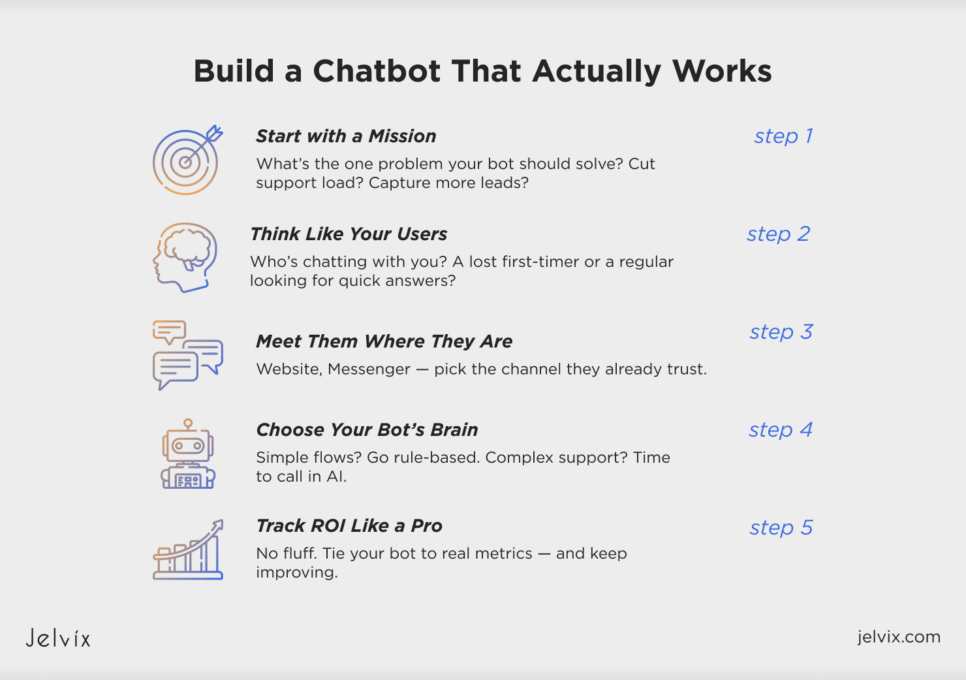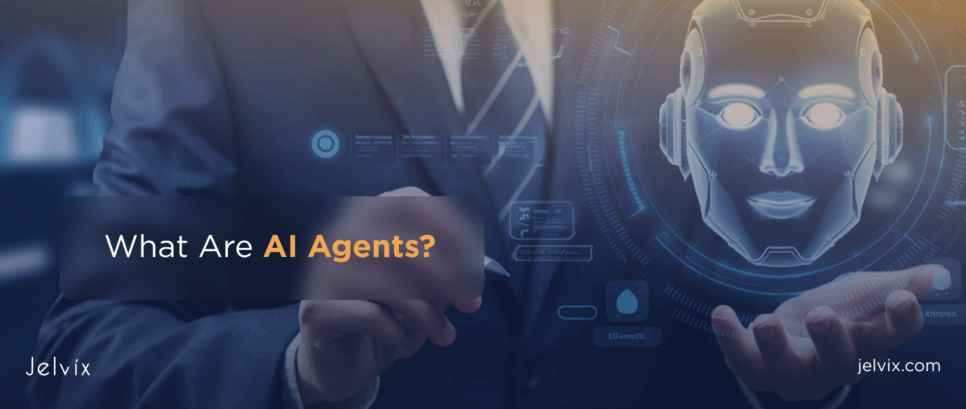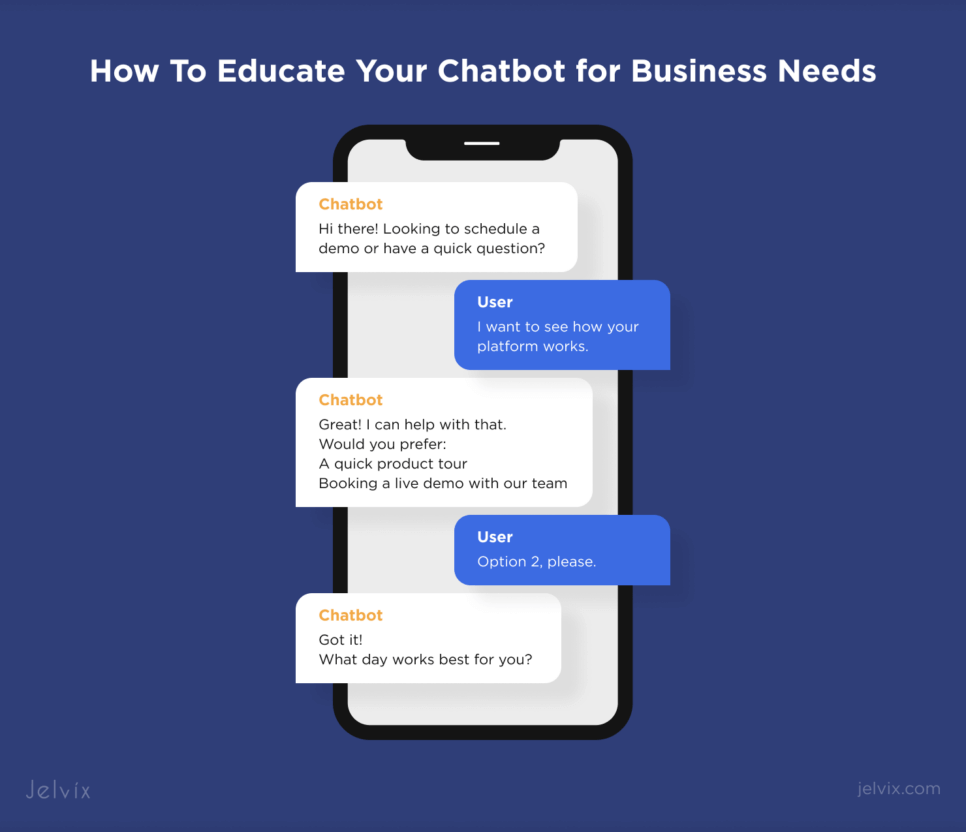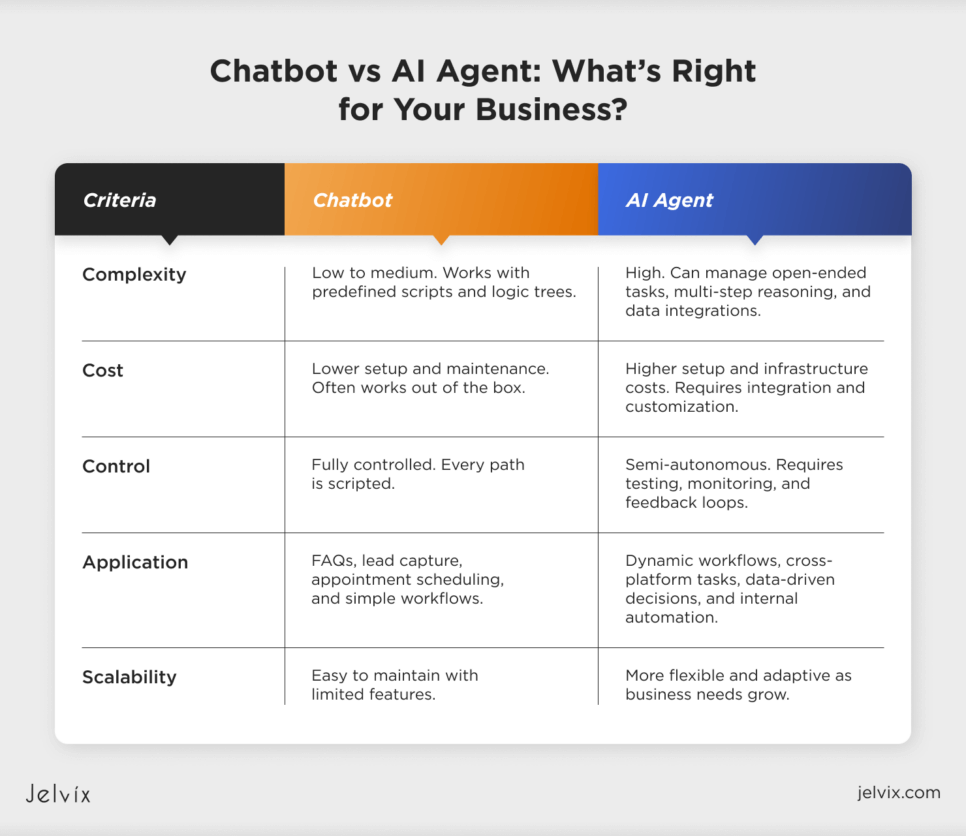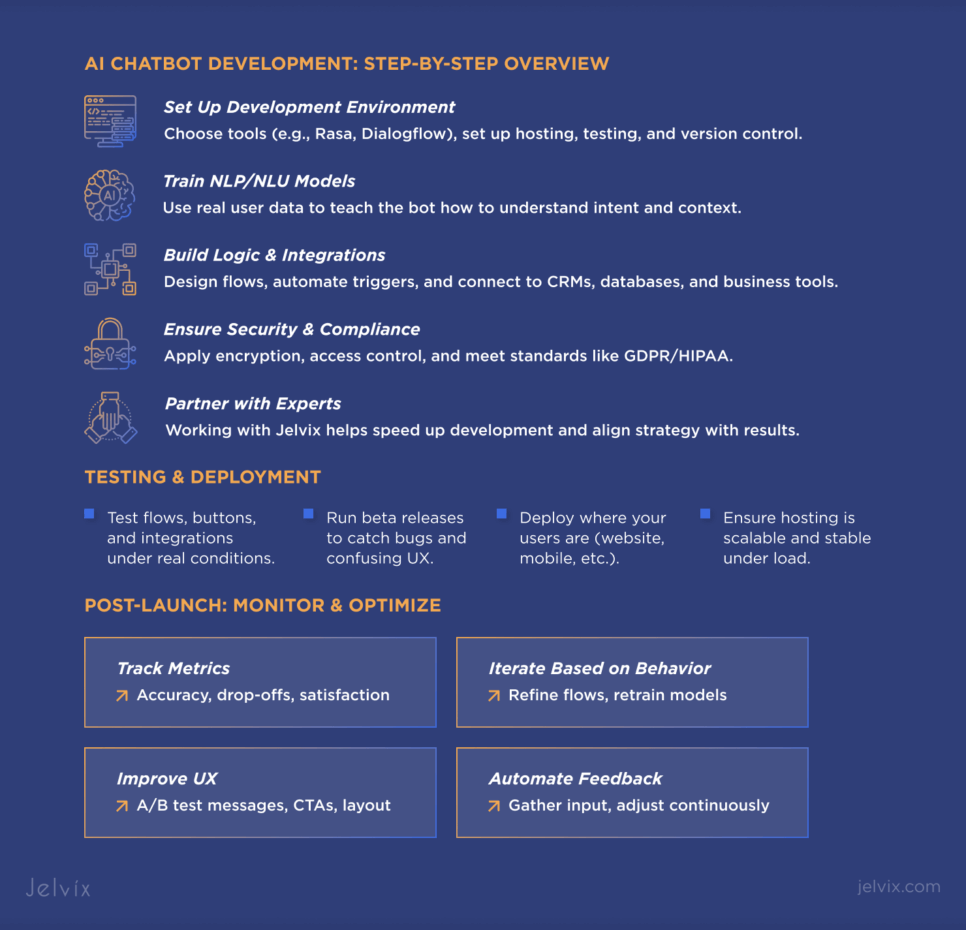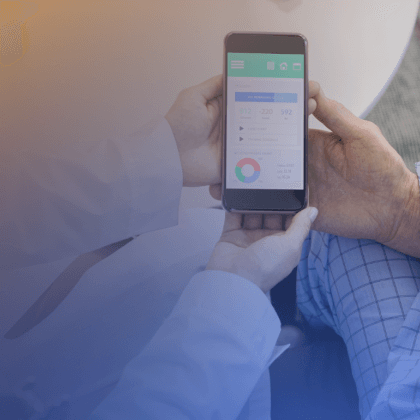Chatbots are no longer just a tech trend, but an asset for businesses that want to scale and grow. That’s why more companies, from startups to global enterprises, are investing in custom AI chatbot development, pushing the market to reach USD 329.46 Bn by 2030.
However, AI chatbot development can be challenging. With so many tools, frameworks, and regulatory requirements, it can quickly get overwhelming and drain your budget.
If you want to build a chatbot to grow your business, engage users, and increase sales, read this article. You’ll find out what chatbots best suit your goals, discover popular use cases in various niches, and get chatbot implementation best practices.
Understanding Chatbot Software
Chatbots are getting extremely popular among consumers, with 82% saying they prefer talking to a bot instead of waiting for a human customer representative to connect. No need to say that customer preferences are a proven indicator of future service trends, and businesses that adapt quickly often see better satisfaction rates and operational efficiency.
Rule-Based vs AI-Powered Chatbots
Before investing in chatbot development, it’s important to choose the right type for your needs.
Rule-based chatbots follow a predefined script. They can be perfect for handling straightforward queries like “What are your opening hours?” or routing users to the correct department.
AI-powered chatbots are more advanced because they use natural language processing, which helps them comprehend user intent and adapt conversations. These are better suited for complex workflows or a wide range of customer questions.
Some companies also use AI bots to integrate advanced features, such as payments, identity checks, or data verification, often supported by blockchain as a service, to ensure added security and transparency in chatbot interactions.
Common Chatbot Use Cases Across Key Industries
Chatbots are incredibly versatile. Depending on how you design them, they can reduce operational costs, increase conversions, and improve customer satisfaction.
Healthcare
Clinics invest in medical software development services to build chatbots that can book appointments, send reminders, and offer basic symptom checks. This approach helps reduce no-shows and keeps communication smooth.
Learn how healthcare chatbots enhance patient care, reduce costs, and optimize clinical workflows through real-world applications and expert insights.
Customer Support
Chatbots handle common questions like order tracking or return policies, offer 24/7 service, and reduce pressure on support teams. For many e-commerce companies, this means faster responses and lower costs.
Sales and Lead Generation
Chatbots qualify leads, recommend products, and book website calls or demos. SaaS and service-based businesses often use AI bots to guide visitors and boost conversion rates.
Marketing
Chatbots help marketers engage users through personalized messages, special offers, or quick surveys. It’s a simple way to capture emails and keep people interested.
HR and Internal Use
Chatbots can answer employee questions, schedule interviews, or guide new hires through onboarding, saving time and reducing back-and-forth emails.
Benefits of Chatbots for Business Development
Chatbots can deliver measurable value for companies investing in medical, sales, or financial software development services.
24/7 Customer Support
Chatbots work around the clock, answering questions, resolving issues, and guiding users even outside business hours. This approach improves customer satisfaction without requiring a larger support team.
Reduced Operational Costs
By automating routine conversations and tasks, businesses save on staffing costs and reduce the burden on internal teams. Fewer repetitive tickets mean more time for high-impact work.
Improved Engagement and Personalization
Chatbots can adapt conversations based on user behavior, location, or preferences. Such a level of personalization keeps users engaged and more likely to explore your offerings.
Enhanced Lead Generation and Conversions
Instead of waiting for users to fill out forms, chatbots qualify leads in real time, asking the right questions and pushing them toward the next step, like booking a call or completing a purchase.
Real-Time Data and Automation
Chatbots can track common issues, user preferences, and drop-off points, giving you insights on how to improve processes. They also trigger automated workflows without manual input, like sending emails or updating CRMs.
Planning Your Strategy To Create a Chatbot
A chatbot is only as effective as the strategy behind it. Before jumping into development, align the chatbot with your needs and user expectations.
Define Purpose and Business Goals
Begin by identifying a specific problem you want to solve, such as reducing support tickets, qualifying leads, or increasing conversions. Your chatbot should have a focused role directly linked to measurable business outcomes.
Identify Your Audience and Their Pain Points
Know who you’re building for—first-time visitors needing guidance or returning users looking for quick support. Understanding their goals and pain points can help you create relevant conversations.
Select Communication Channels
Decide where the chatbot will live. Your website is a great starting point, but depending on your audience, platforms like Facebook Messenger or even SMS might be more effective. Choose channels that your users already trust and use.
Decide Between Rule-Based or AI-Powered
Rule-based bots are simpler and better for predictable conversations, while AI-powered bots can handle more complex queries. Choose based on the complexity of tasks and the level of personalization you want.
Achieving ROI with Your Chatbot
Maximizing returns from chatbot development means aligning the tech with clear goals and continuous improvement.
“To get real ROI from a chatbot, you need to define success metrics, like lead conversion rates, support ticket deflection, and average response time, from the start,” says Oleksandr Andrieiev, CEO at Jelvix. “Then it’s about listening to users and improving your flows, scripts, and training data.”
How To Design Chatbot Conversation Flow
Once you know what your chatbot needs to achieve, the next step is designing how it communicates.
Map User Intents and Expected Flows
List what users might ask, such as booking a demo or checking an order. Then, plan how the chatbot should respond in each situation.
Create a Conversational UX
Write messages in a tone that fits your brand. Keep it simple, add fallback responses, and always give users a way to reach a real person if needed.
Handle Edge Cases and Multilingual Users
Not all users follow the expected path. Plan for incomplete answers, typos, and unusual requests. If needed, support multiple languages or detect them automatically.
Incorporate Personalization and Dynamic Replies
Use available data to greet users by name, recall past actions, or suggest relevant products. This makes the chatbot feel more intelligent and helpful.
AI-Powered Chatbots vs Intelligent AI Agents
As businesses seek smarter automation, AI agents are stepping in to handle more complex tasks than traditional chatbots can resolve.
What Are AI Agents?
AI agents are software programs that can make decisions and take actions on their own to achieve specific goals.
Traditional chatbots follow scripted flows or rule-based decision trees. They’re great for answering FAQs, collecting info, or directing users to the right place. AI agents, on the other hand, can understand open-ended requests, make decisions, and pull data from multiple sources.
Use Cases of AI in Business
AI agents are designed to go beyond simple replies. They get things done across platforms like Slack, Google Workspace, or HubSpot, reducing manual work and improving speed across the board.
For example, an AI agent can support real estate teams by pulling listings, updating availability, or responding to buyer queries in real time—something a real estate software development company often builds into custom CRM systems.
In operations, it can automate onboarding workflows, manage team schedules, or generate status updates, while in customer success, it will review support tickets and offer next-step suggestions.
“We believe that, in 2025, we may see the first AI agents ‘join the workforce’ and materially change the output of companies,” says Sam Altman, OpenAI CEO, in his blog. “We continue to believe that iteratively putting great tools in the hands of people leads to great, broadly-distributed outcomes”.
Integrating with Tools Like Slack, Notion, or CRMs
AI agents work best when connected to the tools you already use. For example, an AI agent in Slack could instantly update your CRM, create a task in Notion, or send follow-up emails based on a short command.
Explore how integrating chatbots with CRM systems boosts customer engagement, automates workflows, and drives sales efficiency.
Tech Behind AI Agents: LLMs and Smart Architecture
Modern AI agents use large language models like GPT-4, Claude, or Gemini to understand language, follow context, and handle tasks. They’re often built with tools like LangChain, AutoGPT, or Microsoft Copilot to enable multi-step logic, autonomy, and easy integration with business tools.
Tool Use, Memory, and Real-Time Data Access
AI agents can remember past conversations, access up-to-date information via APIs, and switch between tools as needed. This makes them suitable for handling multi-step tasks and not just answering questions.
Autonomous Loop vs Human-in-the-Loop
Some agents run in an autonomous loop. They plan, act, and iterate without human input. Others keep a human-in-the-loop for review and control, which is often preferred in regulated industries like finance or healthcare.
Should You Use a Chatbot or an AI Agent Assistant?
Everything depends on what you need. If your business seeks simple, consistent communication, start with a chatbot. Consider an AI agent if you want to automate decision-making or connect multiple tools.
How To Educate Your Chatbot for Business Needs
Train your chatbot using real business data like FAQs and support tickets so it understands your customers. Give it a clear task, such as tracking orders or booking a demo, to keep conversations focused.
Also, use a consistent tone that matches your brand. Set up response templates and fallback replies, and connect the chatbot to your tools to update records or send follow-ups.
Keep testing after launch and improve your solution based on user behavior. Ensure it can handle unexpected inputs and knows when to hand things over to a human.
Chatbot vs AI Agent: What’s Right for Your Business?
Choosing between a traditional chatbot and an AI agent depends on what you’re trying to achieve. A quick comparison will help you decide.
Best AI Agents: Examples of Top Platforms
If you’re exploring AI agents, here are a few standout platforms and frameworks that make it easier to build action-oriented assistants.
LangChain
An open-source framework that lets you build advanced AI agents by connecting language models with tools, APIs, memory, and reasoning chains. Ideal for developers creating custom workflows.
AutoGPT
An experimental setup that lets agents set goals and self-execute tasks by planning, reasoning, and adapting. It’s best for exploring autonomous task execution with minimal human input.
ReAct
A method for structuring agent behavior by combining language reasoning with external actions. It can be helpful in building AI that can both think and do, especially in multi-step workflows.
Microsoft Copilot
A practical enterprise-ready AI assistant integrated into Microsoft 365 apps like Outlook, Teams, and Excel. It is suitable for businesses that want intelligent productivity tools with minimal setup.
GPTs with APIs
Custom GPTs can now be connected to real-time data, internal tools, and external APIs. This allows businesses to create tailored AI agents with specific skills and secure access to internal systems, without building everything from scratch.
How To Design a Chatbot: Choosing the Right Tech Stack
The tools you choose will shape how fast you build, how easily you scale, and how well your chatbot fits into your business. The best stack depends on your goals, budget, and technical capacity.
Top 6 Popular Platforms: An Overview
There are many platforms available for building AI agents and chatbots for business, each offering different levels of control, customization, and ease of use.
Dialogflow
This tool by Google is great for voice and text-based AI chatbots. It supports multi-language NLP, integrates well with Google Cloud, and is ideal for service bots that require smart intent handling.
Rasa
It is an open-source framework giving full control over the chatbot’s logic, NLP pipelines, and data. It’s a top choice for developers building enterprise-grade bots that need custom behavior or on-premise deployment.
Microsoft Bot Framework and Azure AI
These are powerful tools for building, testing, and deploying AI agents across channels like Teams, websites, and mobile apps. They work well for large organizations already using Microsoft services.
Botpress
This tool is designed for developers who want flexibility and a visual interface. It features built-in NLP, custom flows, and is open-source, allowing you to host it anywhere.
Manychat
It is popular in e-commerce and marketing for building Facebook Messenger, WhatsApp, and Instagram bots. No coding is needed, and it’s built for lead generation, customer engagement, and sales automation.
Tidio
It is a user-friendly, all-in-one platform combining live chat with AI automation. Best for small to mid-sized businesses looking to offer real-time support, automate FAQs, and qualify leads.
Choosing Between Low-Code, No-Code, and Custom-Built Tools
No-code platforms generally suit small businesses that need fast and simple solutions, like customer service bots or lead capture forms. On the other hand, low-code tools provide more flexibility and allow developers to fine-tune logic while still speeding up development.
Finally, custom-built solutions are best for businesses with complex workflows, deep system integrations, or strict compliance needs. These require full-stack development but offer maximum control.
Commonly Used Chatbot Programming Languages
Most chatbot and AI agent development today happens in Python and JavaScript or Node.js.
Python is best suited for working with AI, NLP, and frameworks like Rasa, LangChain, or GPT-based tools, while JavaScript and Node.js are popular for web integrations, backend services, and frameworks like Botpress or Microsoft Bot Framework.
Choosing the right language depends on your software development team structure, their skills, and the complexity of the project.
Key Integrations To Consider in Your Chatbot Development Process
To make your chatbot or AI agent truly useful, it needs to connect with your core tools.
Some essential integrations include:
- CRMs: HubSpot, Salesforce, and Zoho for managing leads and tracking conversations;
- Databases: MySQL, MongoDB, and Firebase for storing and retrieving structured data;
- Analytics: Google Analytics, Mixpanel, and Dashbot to track performance and user behavior;
- Payment Systems: Stripe and PayPal to allow transactions directly within chat flows.
These integrations can turn your bot into more than a conversation tool and make it a seamless part of your business operations.
AI Chatbot Development: A Step-by-Step Guide
Once your strategy is clear and your tools are selected, it’s time to build your chatbot.
1. Set Up the Development Environment
Choose your platform, like Rasa or Dialogflow, set up hosting, and configure your workspace for coding, chatbot testing, and version control.
2. Train NLP/NLU Models
If using AI, feed your chatbot real examples of user input to help it understand intent and respond accurately.
3. Build Logic, Flows, and Integrations
Design conversation flows, set up triggers, and ensure chatbot integration with CRM systems, databases, and other tools to automate tasks and improve data access.
4. Ensure Security and Compliance
Add encryption, role-based access controls, and data handling policies to protect user information and stay compliant with regulations like GDPR or HIPAA.
5. Work with Jelvix as a Tech Partner
Partnering with Jelvix gives you access to expert development, seamless integrations, and AI training, so your chatbot delivers real business results in a shorter time. Working with a tech partner also helps unite scattered ideas into a clear strategy focused on outcomes.
How To Make an AI Chatbot: Testing and Deployment
Before your solution goes live, use proven chatbot testing and deployment strategies to ensure it works as expected under real-world conditions.
Check that all flows, buttons, and integrations work properly. Test for bugs, broken links, and edge cases. Performance testing helps ensure your chatbot responds quickly, even under high traffic. Also, release a beta version to a small user group to spot confusing flows or missing responses, and improve them before full launch.
Decide where your chatbot will work. Most businesses start with their website, but you can also deploy it on mobile apps, depending on where your audience is most active.
Finally, ensure your hosting can scale and handle traffic spikes without slowing down.
Monitoring, Maintenance, and Optimization of Your Chatbot Platform
Launching your chatbot is just the beginning. To keep it effective, ongoing tracking and improvement are essential.
Track Key Metrics
Monitor performance indicators like response accuracy, satisfaction scores, resolution rates, and where users drop off. These insights show what’s working well and what needs fixing.
Update Based on Behavior
As users interact, patterns will emerge. Use that data to refine your chatbot’s logic, expand intent recognition, and retrain NLP models to improve accuracy over time.
Improve UX
Run A/B tests on messages, flows, and CTAs to see what drives better results. Even minor tweaks ike changing a greeting or adjusting button text can boost engagement.
Automate Feedback Loops
Use built-in surveys or follow-up messages to gather user feedback automatically. Feed those insights into your chatbot training and update cycles for smarter automation.
Developing an AI Chatbot: Real-Life Case Studies
Across industries, companies use chatbots and AI agents to optimize operations and boost efficiency. Learning from successful cases can help you spot opportunities, avoid common mistakes, and build a realistic plan for your business.
Cutting Servicing Times
Zurich Insurance deployed an AI-powered CRM across four markets to help agents access and suggest tailored insurance products. They experienced up to 70% faster service and better customer interactions as a result.
Increasing Gross Sales
JPMorgan Chase reported that its Coach AI significantly enhanced performance during the April 2025 stock market turmoil. The tool helped advisors respond faster to market volatility and client needs. As a result, they saw a 20% increase in wealth management sales and $1.5B in operational savings.
Using AI Agents To Manage Patient Care
Healthcare startup Ascertain uses AI agents to handle clinical documentation and administrative tasks. Partnering with Northwell Health, they’re reducing clinician workload and improving care delivery.
How To Make Chatbot Implementation Smooth with Expert Guidance?
A carefully designed and wisely implemented chatbot can do much more than automate replies. It can improve business operations, support your team, and offer a whole new way to connect with customers. At the same time, having expert guidance can help you move faster and avoid costly mistakes.
As an experienced tech partner, Jelvix helps businesses across industries turn fragmented ideas into a cohesive chatbot strategy. Instead of disconnected features, you get a unified system built to deliver measurable business results.
If you’re ready to take the next step, reach out for a consultation. We’ll help you shape a chatbot strategy that fits your goals, budget, and business model.
FAQ
How much does it cost to build a chatbot from scratch?
Costs vary based on complexity, features, and platform. Moreover, ongoing maintenance and integrations may add to the total price.
What is the first step in chatbot development?
The first step is defining the chatbot’s purpose and business goals. Identify what problems it should solve, who it will serve, and how it can fit into your existing workflows.
How do AI chatbots work in customer service?
AI chatbots use NLP to understand and respond to user questions. They can resolve common issues, provide instant answers, and escalate complex queries to human agents when needed.
What is the difference between a chatbot and an AI agent?
A chatbot follows scripted flows and handles routine tasks. An AI agent is more advanced, using real-time data, reasoning, and tool integrations to perform actions and adapt to complex workflows.
Can a chatbot integrate with my CRM or website?
Yes. Most modern chatbots can be integrated with CRMs like Salesforce or HubSpot, as well as websites, mobile apps, and messaging platforms to sync data and automate tasks.
Transform bold ideas into measurable results.
Partner with a software development team built around your goals—offering full control, strategic agility, and outcomes that matter.

